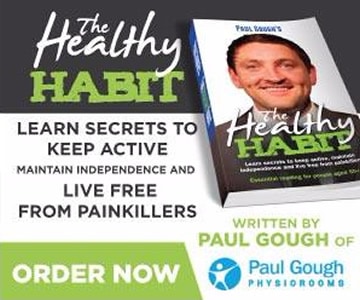Are you getting pain in your shoulder and worried about why it could be causing you pain?
We know that it can be scary not knowing why your shoulder is hurting or if it is a cause for concern.
Usually, you can be reassured that nothing sinister is going on!
We speak to hundreds of patients who come to us with pain in different parts of their shoulder.
We’ve put together this blog to explain 3 points on your shoulder where you may feel pain, the cause of your pain and 5 solutions to help you ease stiff and painful shoulders.
Why Am I Getting Shoulder Pain?
In our clinics we typically treat shoulder pain in these three areas.
Pain At The Top Of Your Shoulder
The first area of your shoulder you may be experiencing pain in is the top of your shoulder. This is called your AC joint where your collar bone and the top of your shoulder meet. This joint is held together by strong ligaments.
The top of your shoulder may begin to hurt or ache due to direct injury. This could be bumping your shoulder off an object or falling onto it.
Other reasons could be general wear and tear due to your age or repetitive activity. If you do a lot of heavy lifting or exercise with your arms, this can cause the joint to swell and become painful to move as well as restricting your movement.
Your Shoulder Blade Pain
Pain in your shoulder blade is sometimes described by patients as a dull and sore ache, a shooting pain up the part of the back between the shoulder blades or a hard knot underneath one of your shoulder blades.
This type of shoulder pain is usually related to muscle strain from exercise or heavy lifting, sleeping in an uncomfortable position or poor posture.
Pain From Your Rotator Cuff
Your rotator cuff is a group of muscles and tendons that surround your shoulder joint keeping your upper arm in place while allowing you to have a broad range of movement in your shoulder.
Rotator cuffs can become torn for two main reasons.
The first is an acute tear resulting from falling on an outstretched arm or lifting something heavy with a jerk-like motion.
The second is related to wear and tear as you get older. A common issue in people over 40 sees their rotator cuff tendons be worn down over time with overuse. This issue is also more likely to develop in your dominant arm (the arm you do most things with).
How To Ease Your Shoulder Pain Naturally
Pause Physical Activity
We understand you may have been told to rest in the past and it hasn’t given you any long term relief.
However, to give your shoulder pain time to heal, you should pause any strenuous physical activity for a couple of days.
This could not only ease your shoulder pain but also prevent further injury to your shoulder.
Once you’ve rested for a while, you should reintroduce movement slowly which means easing yourself back into exercise and avoiding lifting heavy objects.
If it doesn’t improve with rest, and is still causing you problems after a week, it’s likely there is a more serious injury which needs specialist help.
Ice Or Heat Therapy
Ice or heat therapy can help you if you are in immediate pain and give you an alternative to strong painkillers which we know lots of people want to avoid.
Placing ice onto the sore area of your shoulder for up to 20 minutes at one time can create a numbing effect against the pain.
Heat therapy should be used in bursts of up to 20 minutes on the area of the shoulder that is in pain.
It’s important to note that you should only use one of these therapies every two hours and use a layer between the ice or heat and your shoulder to protect your skin.
However, you can interchange these therapies and work out which one suits you better.
Massage
Pain in your shoulder blades can often feel like a tight knot if you’ve pulled a muscle.
Massaging is a fantastic natural way to give you some pain relief as well as loosen up any stiffness and allow your muscles to relax, giving you a wider range of movement without any pain.
A Different Sleeping Position
Sleeping positions can sometimes make shoulder pain worse or even allow it to develop.
A side-sleeping position you could try to ease your shoulder pain is lying on the non-painful shoulder whilst pointing the painful one to the ceiling. Then, take a pillow and place it in the armpit of the injured shoulder.
This will allow the injured shoulder to be held up slightly, taking the pressure off your rotator cuff, giving you enough pain relief to get a good night’s sleep!
If you have shoulder blade pain, a good sleeping position to try is lying on your back with a small pillow nested between your shoulder blades.
Shoulder pain often occurs in the morning due to our bodies lying too flat during the night.
How Physiotherapy Can Ease Your Shoulder Pain Long Term
If your shoulder pain is getting worse and you’re worried that you are losing movement in your arm, or you’ll have to have a painful injection, physiotherapy could be the natural solution you’ve been looking for.
Our team have worked with thousands of patients suffering with agonising shoulder pain just like you and could get you moving normally again in a matter of weeks!
Right now, we are currently experiencing extremely high demand in our clinics, but we are offering a limited number of free shoulder pain consultations.
Within your free shoulder pain consultation, you can find out more about physiotherapy and understand the best treatment options available to you.
Arrange your free shoulder pain consultation with our simple webform, or if you prefer to talk over the telephone, you can call us on 01429 866 771.
More Natural, Drug-Free Solutions To Your Shoulder Pain
Our founder, leading UK physiotherapist, and multi-time No.1 bestselling author Paul Gough has written a FREE downloadable report for anyone who is suffering with neck and shoulder pain and wants to know…
“How To Ease Annoying, Daily, Irritating Neck and Shoulder Pain Naturally – Before It Gets Any Worse…”.
Click Here To Download Your Free Neck And Shoulder Pain Report
Over the last 15 years, we have helped THOUSANDS of people in the North East across our four clinics; Darlington, Durham, Guisborough, and Hartlepool and more and more people are putting their faith in private physiotherapy.
If you’re currently stuck on the NHS waiting list, and wondering whether private physiotherapy is right for you, we have put together a blog article which outlines 6 major differences between the NHS and private physiotherapy.
Click Here To Read About The 6 Major Differences Between The NHS And Private Physiotherapy
Other Free Resources For Shoulder Pain
Click Here To Read – Expert Advice For Fast Shoulder Blade Pain Relief
Click Here To Read – Is Swimming Good For You If You Suffer From Shoulder Pain
Click Here To Read – Most Common Shoulder Problem And How To Fix It
We also have free, downloadable reports for people with Neck And Shoulder Pain
Want videos on demand? Check Out Our YouTube Channel (Remember to hit subscribe so you don’t miss out on our new videos!)
On social media? Follow us on Facebook, Instagram or LinkedIn


